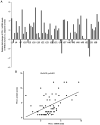Expression of PD-L1 and CD4+ tumor-infiltrating lymphocytes predict survival in head and neck squamous cell carcinoma
- PMID: 35111324
- PMCID: PMC8771311
- DOI: 10.3892/mco.2022.2492
Expression of PD-L1 and CD4+ tumor-infiltrating lymphocytes predict survival in head and neck squamous cell carcinoma
Abstract
The clinical efficacy of immune checkpoint blockade has been recently demonstrated in a variety of cancer types. The aim of the present study was to characterize the expression profile of tumor-infiltrating lymphocytes (TILs) and programmed death-ligand 1 (PD-L1) in head and neck squamous carcinoma (HNSCC). A total of 63 patients with HNSCC were enrolled in the present study. CD3+ and CD4+ TILs and the expression of PD-L1 were detected by immunohistochemistry. PD-L1 mRNA levels were evaluated by reverse transcription-quantitative PCR analysis. The association of TILs and PD-L1 with patient clinicopathological characteristics was also assessed. CD3+ and CD4+ TILs were detected in 100% of the samples. CD3+ was the predominant subset of TILs. PD-L1 was expressed in 53 of 61 (86%) patients when a score of ≥1 on tumor cells was considered positive and in 28 patients (45.2%) when a score of >5 on tumor cells was considered positive. PD-L1 mRNA levels were determined to be significantly correlated with PD-L1 protein expression. Survival analysis demonstrated that high CD4+ TILs were associated with improved overall survival (OS) and disease-free survival (DFS), and furthermore, the association of high PD-L1 expression with unfavorable OS and DFS was statistically significant. Multivariate analysis identified CD4+ TILs and PD-L1 as prognostic markers for HNSCC. The results of the present study suggested that increased CD4+ TILs in HNSCC may be associated with improved outcomes, while high expression of PD-L1 may indicate unfavorable OS and DFS; thus, these factors may serve as predictors of the response to immune checkpoint therapy.
Keywords: PD-L1; head and neck squamous cell carcinoma; prognostic value; tumor-infiltrating lymphocytes.
Copyright: © Fu et al.
Conflict of interest statement
The authors declare that they have no competing interests.
Figures



References
LinkOut - more resources
Full Text Sources
Research Materials
